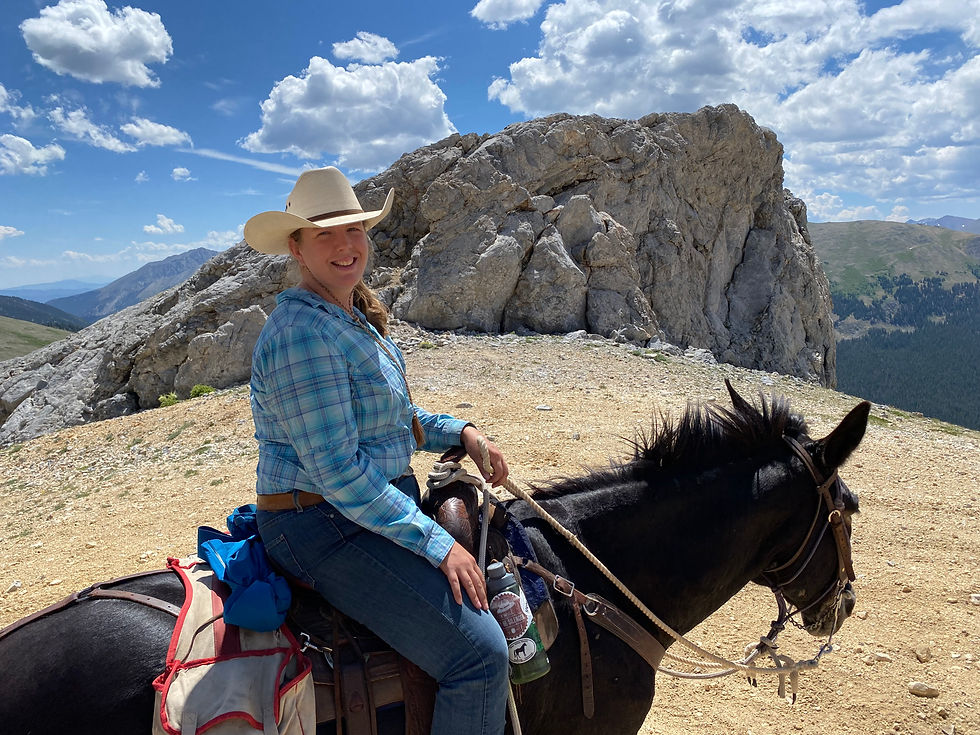The Power of Trust in Horsemanship
- Rebecca Sheriff

- Jan 27, 2022
- 4 min read
Updated: Oct 20, 2023

My mind tends to wander when I’m on the back of a good horse walking down the trail. I’m in awe of the beauty around me and thankful for the good people behind me as we explore the mountains of central Colorado. But going for a trail ride is hardly a simple goal for a horse. While the end goal may sound elementary - “I want you to walk down the trail and cross anything we come across without any issues” - the process is anything but easy.
First, you have the basics. Care, feed, vetting, farrier work, shelter, and a herd mate or two. A horse’s environment and level of care will go a long way towards a future career as a successful equine citizen.
Then, you have your groundwork. Building the foundation on which your horse will stand, the horse must be exposed to dozens of situations before putting your foot in the stirrup. After the foundation of groundwork is laid, then begins training under saddle. Entire books have been written about starting a horse under saddle, yet the basic premise is that everything that is done on the ground should translate into the saddle. However, when you’re riding a horse you add your own emotions, actions, reactions, variables, and movements into the equation. So now, not only does the horse have to yield parts of his body when and how you ask, he has to do so while understanding his rider’s cues and body movements. Even something as simple as walking forward in a straight line can become complicated when you factor in rider and environmental factors.
Let’s assume you have a horse that is solid with her groundwork and is going nicely in the arena or round pen under saddle at the walk, jog, and lope. She has a nice handle on her, solid brakes, and can turn left and right. Next comes the trail exposure.
Just as everything on the ground applies to work in the saddle, everything in the arena applies to life on the trail. Except now, you’ve taken away the perception of a controlled environment and added in potential unknown variables (ATVs, loose dogs, a group of hikers, wildlife, etc.)
Going on a trail ride also typically involves the added variables of trailering, riding solo away from the herd, riding in new country that feels unfamiliar, riding in less-than-perfect weather, and many other situations. Not only does the horse have to remember all its previous lessons, it must also continually turn to its rider for guidance and reassurance. The h
orse is asked to set aside his own instincts and put his faith in his human leader.
When you consider all of these things - groundwork, arena riding, and training on the trail - suddenly a simple trail ride doesn’t sound so simple. A horse becomes a partner that has thousands of hours invested into his physical and emotional development. A horse with a seemingly simple job description of “trail horse” holds an incredible amount of responsibility when we think about the precious cargo we ask them to carry: our friends, grandparents, children, and students.
So how do we achieve this trail horse status? One that can be trusted to carry people into the mountains with little drama or uncertainty? All horses are developed by taking a big goal, “going for a trail ride,” into the smallest steps imaginable.
“Walking down the trail” unites dozens of previous training goals. For example, each of the steps below must happen before a pleasant trail ride can occur. And each of the steps below can be individually broken down into smaller and smaller steps. The list of small steps is nearly infinite and difficult to capture in words on a page.
Giving to pressure
Accepting tack
Accepting a rider
Connecting movements to cues
Understanding directional control
Understanding emotional control (i.e. how to react in a desired way, even when spooked or nervous)
Understanding speed control
Knowing how to stay balanced with a rider
How to trust a rider’s leadership over one’s flight instincts
So what is the smallest step? What first step must be achieved in order to start the process of developing a relationship with a horse? I believe the answer to that question is trust.
Trust is not a button that can be pushed or a command to be given, but it is at the root of horsemanship. If a horse does not trust its handler to treat him with kindness, consistency, and care, the partnership will go nowhere. If a rider does not trust her horse to connect training to action, she does the horse a great disservice.
Let’s connect this all to faith. Just as we are called to be faithful stewards and leaders of our horses, we are called into a relationship with our Provider. If I do not trust that God is graceful and forgiving, I could never move past my mistakes to learn and grow from them. If I don’t set aside my own instincts of self-preservation and independence, I can never know the power of a personal relationship with the Creator of the mountains I gaze at. We are able to love, care, and trust because Jesus first did these things for us.
Trust. It’s the core behind any relationship. And it is a core building block in the training of any horse. With a foundation of trust, blocks can be built into a foundation that will hold up the career of any horse or person. Including those who enjoy a simple trail ride on a solid horse.





Comments